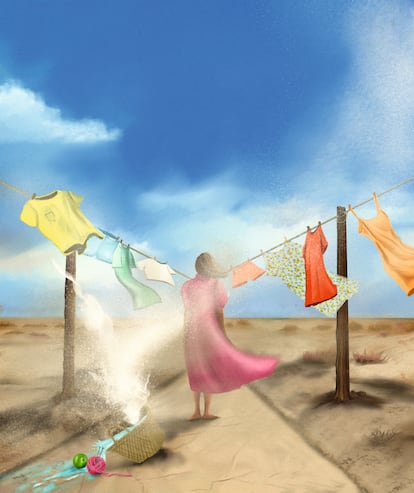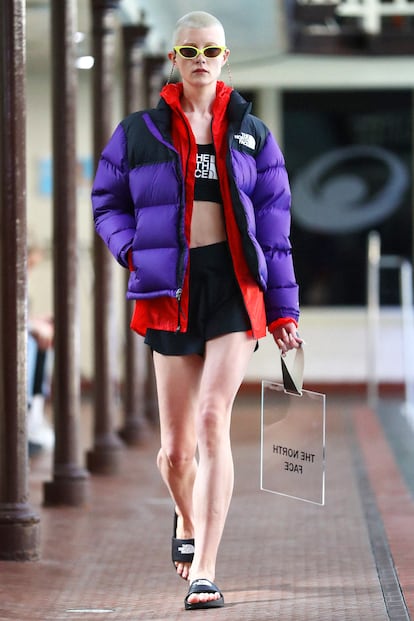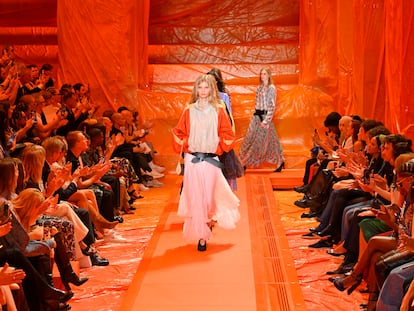The end of seasonal wardrobe changes and disrupted calendars: How climate change affects the fashion industry
Fashion brands are entirely convinced that climate change is a fact. It’s already here, and we must adapt quickly

On a winter day sometime in the near future, a grandmother and her granddaughter go shopping under a blazing sun. They are wearing clothes made of state-of-the-art polymers that promise the same cooling effects as linen and other natural fibers that are already too expensive for the middle class. They have gone out in search of warm clothing for the new squall Federica, which is set to freeze the entire country in just a few days. The grandmother, looking at the selection of technical garments, comments to her granddaughter that, years ago, they used to buy nice wool coats in September. The teenager smiles and nods, but she thinks that her grandmother is already losing her memory and confusing dates. How can that be possible, if during that month you see nothing but sandals and tank tops?
This imagined scene is not so far away. In fact, if we look at the current fall window displays in the Northern Hemisphere, few stores are bringing out their mid-winter selection during these months. Fashion brands are more than convinced that climate change is a fact. It is already here; we must adapt and fast. Some of the best-known brands have set ambitious sustainability goals and are working hard to meet the deadlines. Others, like Balenciaga, are trying to touch our heartstrings through their creative production: its fashion show with a flooded catwalk for the autumn-winter 2020 season and its 2022 winter show that recreated a snowstorm, were intended to focus on the climate emergency, although there were criticisms that the shows presented the climate crisis from a romantic point of view. But behind all these gestures and calls for awareness, the truth is that brands are working hard to adapt to a new reality. We are seeing how a series of the industry’s deep-rooted practices are being dismantled in the backroom: the classic rhythm of collections has been confirmed as irrelevant, production cycles are disrupted, winters are impossibly short and buying teams are monitoring the ups and downs of the weather map.

“The popular seasonal wardrobe change no longer exists,” says Gemma Albi Verdú, Gap’s global brand and communications director. “In recent years we have moved from designing products for a specific season to offering more [multi-season] items. We have implemented a strategy that prioritizes the versatility and longevity of the pieces,” she says. “Before, our collections were 80% on-trend and the rest [were] carryover garments from the previous season or basic garments. Today that ratio has been reversed,” she adds.
The contents of the campaigns are also executed with an unpredictable climate in mind, as reflected visually: “At the styling level, at Gap we have adapted by prioritizing perennial pieces and building different styles around them. For example, the traditional white shirt can be worn in the middle of the summer with denim shorts or under a sweater with a maxi skirt and boots on a rainy day. On shoots, we make sure to capture different looks with the same product so that we can be more reactive at launch time.” As Albi points out, flexible strategies and short-term reaction are key for big brands to be competitive in an industry affected by macroeconomic and environmental factors. For example, the ultra-flexible giant Inditex is changing its sales calendar, which is less and less subject to traditional seasons. The company now devotes only three months a year to heavy winter garments, when it used to devote about four and a half months. To respond to its customers’ buying impulses, down jackets no longer go on sale on the traditional autumn dates; they come into the store during the cold months of January and February. Then they are a big hit.

Global and local challenges
Suppliers for Ortega’s empire have also had to restructure their systems and abandon old patterns. They now receive orders for outerwear in December and Bermuda shorts in summer, instead of such production requests coming in months in advance. In addition to these changes, there is the challenge of working with factories in countries where temperatures are constantly rising, places with infrastructures failing due to heat, power outages, typhoons, and locations with shortages of certain materials due to extreme weather. It is more difficult to plan for everything.
While the big brands have the budget to spearhead the changes, the impact of independent designers should not be underestimated. Smaller, direct-to-consumer firms are taking an increasing share of the market while meeting niche demands. “Smaller brands’ customers know they can turn to them to buy what they need at that moment,” says Jaime Llambias, the founder of the Spanish label J. Llambias. “We no longer have fixed dates for launching collections; it’s your creation, production is small, the workshops are more flexible with few units, and you set the times. We can release summer [collections] late, in May, and sell them through our digital platforms.”
All of this contributes to the fact that in-between seasons are no longer anecdotal, and that in terms of fashion, our year lacks seasonal changes. Items like jackets and trench coats are experiencing a golden age. Burberry reported that its profits increased by 18% between April and June 2023, compared to the same period last year; this jump was primarily driven by sales of its iconic trench coat, which rose 36% from year to year. Vintage trench coats are also among the most popular items on the second-hand and independent designer sales platform ASOS Marketplace.
In addition to changes in temperature, there’s also the rising cost of living and international instability that affects material prices and production. It’s the perfect storm for decimating winter supply. As Llambias explains, “I am fearful of the winter because, among other things, it’s a season that requires expensive materials and, to make matters worse, fabric distributors ask for very high minimums to supply them. You have to sell 150 cashmere sweaters in a short period of time at very high prices. Personally, I make only a few garments, the ones I know will work, and I tend to focus on fine jackets or light knits. In general, customers really like the in-between seasons, because you can dress well easily.”
According to the designer, there is also a constant demand for summer garments throughout the year. “Shopping starts in February, but if I decided to bring out spring dresses in December, I would also sell them. I see that it is also fueled by a certain illusion, by the idyllic image of the Mediterranean, of dressing for a vacation in Italy. People copy a lot of these people, and you don’t know where they come from, where they live, or how they pay for all of it.”
A summer of tomatoes and down jackets
In the world of TikTok, last summer was the summer of the tomato girl, a digital version of dolce vita repackaged for the Z generation. Over the past few months, our social media has been filled with stylish girls walking around with straw baskets, and beautiful people gorging themselves on spaghetti. Suddenly, everyone wanted to take pictures of themselves in Levante, as if they had landed in Amalfi. The second season of The White Lotus, which was shot in sumptuous Sicily, has helped make this aesthetic so aspirational. Videos tagged as “tomato girl summer” on TikTok racked up 62 million views in September, and brands took note. The U.S. boutique Lisa Says Gah launched capsule collections of garments printed with Spanish-style tapas, baguettes, lemons and, of course, tomatoes. In turn, the Spanish brand Compañía Fantástica marketed pieces with illustrations of shrimp in a perfect orangey-pink color. Meanwhile, the residents of those popular areas in southern Europ e— probably oblivious to the trend on social media — protected themselves from the heat wave by keeping their blinds down all the time and not setting foot outside until nightfall.
In the midst of this eternal summer, there is the curious phenomenon of wearing a trendy down jacket to take in the sun. Who hasn’t rolled their eyes at someone wearing a North Face jacket and Nike Air Force sneakers to have a vermouth on a terrace? The figures confirm that the increasingly shorter winter is not causing problems for The North Face. Yes, the 1996 Retro Nuptse jacket model has been seen in high schools as well as at trap concerts. And it has connected the closets of Los Angeles it-girls like Kendall Jenner and Hailey Bieber to the wardrobes of Sunday commuters in the mountains of Madrid, Spain. In May, the brand reported a 12% increase in profits for the year’s fourth quarter, despite VF Corp, the U.S. company that owns The North Face, raising prices.
Is this trend the result of brand-name bias, denialism or pure dissociation? It could simply be a testament to people’s enormous capacity for daydreaming. Wearing a Nuptse when a denim jacket would suffice is, in a way, wanting to think that glaciers will stay in place, dreaming that it will snow at Christmas and that Santa Claus will continue to deliver presents in his sleigh. And in this fantasy that we’ve established, there’s no better company than fashion, which is always there, ready to fuel pipedreams.
Sign up for our weekly newsletter to get more English-language news coverage from EL PAÍS USA Edition
Tu suscripción se está usando en otro dispositivo
¿Quieres añadir otro usuario a tu suscripción?
Si continúas leyendo en este dispositivo, no se podrá leer en el otro.
FlechaTu suscripción se está usando en otro dispositivo y solo puedes acceder a EL PAÍS desde un dispositivo a la vez.
Si quieres compartir tu cuenta, cambia tu suscripción a la modalidad Premium, así podrás añadir otro usuario. Cada uno accederá con su propia cuenta de email, lo que os permitirá personalizar vuestra experiencia en EL PAÍS.
¿Tienes una suscripción de empresa? Accede aquí para contratar más cuentas.
En el caso de no saber quién está usando tu cuenta, te recomendamos cambiar tu contraseña aquí.
Si decides continuar compartiendo tu cuenta, este mensaje se mostrará en tu dispositivo y en el de la otra persona que está usando tu cuenta de forma indefinida, afectando a tu experiencia de lectura. Puedes consultar aquí los términos y condiciones de la suscripción digital.
More information
Últimas noticias
Most viewed
- Sinaloa Cartel war is taking its toll on Los Chapitos
- Oona Chaplin: ‘I told James Cameron that I was living in a treehouse and starting a permaculture project with a friend’
- Reinhard Genzel, Nobel laureate in physics: ‘One-minute videos will never give you the truth’
- Why the price of coffee has skyrocketed: from Brazilian plantations to specialty coffee houses
- Silver prices are going crazy: This is what’s fueling the rally










































